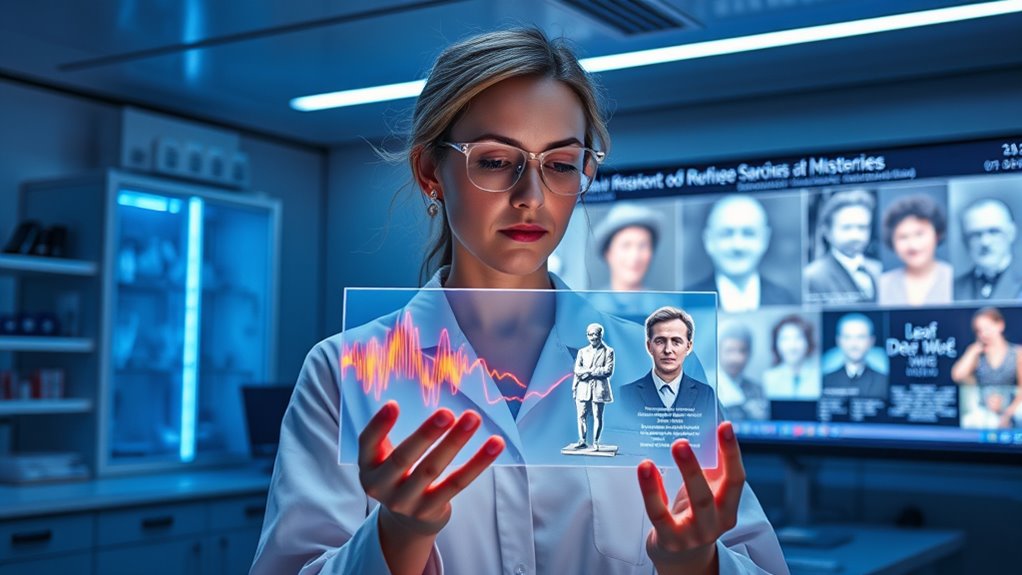Deepfake voice technology can be used for good by helping the deaf community access lost or historical voices. It allows you to experience voices from loved ones who have passed away or famous figures from history, creating a more personal and emotional connection. While these innovations offer incredible benefits, they also raise ethical questions about consent and misuse. If you keep exploring, you’ll discover how responsible use can open powerful, meaningful opportunities.
Key Takeaways
- Deepfake voice technology can restore lost speech, enabling deaf individuals to experience voices of loved ones or historical figures.
- It promotes emotional connections by recreating authentic speech patterns with high fidelity and nuanced intonations.
- Responsible use requires securing consent and verifying voice data to prevent misuse and protect individual rights.
- Such reconstructions support education, memory preservation, and cultural heritage related to deaf history.
- Balancing innovation with ethical standards ensures deepfake voices serve humanitarian and educational purposes effectively.

Deepfake voice technology often gets a bad rap for its potential misuse, but it also holds remarkable promise for good. One of the most compelling applications is reconstructing lost speech for deaf or hard-of-hearing individuals, allowing them to experience voices from the past or voices they never had the chance to hear. This technology uses advanced voice synthesis to recreate authentic speech patterns, intonations, and nuances, giving a personal touch that static recordings can’t match. Imagine being able to hear the voice of a loved one who has passed away or experiencing the voice of a historical figure. It’s a moving way to connect with history and loved ones, bridging gaps that once seemed impossible to cross. The preservation of voice fidelity is essential to ensure these reconstructions feel authentic and emotionally impactful.
Reconstructing lost speech with deepfake technology helps connect loved ones and preserve history in meaningful ways.
However, as you explore this transformative potential, you must also consider the ethical considerations involved. The power of voice synthesis means that voices can be manipulated or falsely attributed, raising questions about consent, authenticity, and privacy. It’s crucial to ensure that such technologies are used responsibly, with clear permissions from the individuals whose voices are being recreated. Without proper safeguards, there’s a risk of misuse, such as creating deceptive audio for malicious purposes or infringing on someone’s identity. Ethical considerations aren’t just about avoiding harm; they’re about respecting the dignity and rights of individuals while harnessing the benefits of this innovation.
When deploying deepfake voice technology for reconstructing lost speech, you’ll want to work with transparent processes. This involves verifying the sources of voice data, securing informed consent, and maintaining strict standards for how the synthesized voices are used. It’s also essential to develop regulations that govern the ethical use of voice synthesis, making sure that the technology serves genuine humanitarian or educational purposes rather than exploitation. As you navigate these considerations, you’ll find that establishing trust and accountability is key to harnessing the true potential of deepfake voices for good.
Ultimately, the promise of voice synthesis in reconstructing lost speech offers a powerful way to preserve history, support the deaf community, and foster empathy. When approached thoughtfully and ethically, this technology can create meaningful connections that transcend time and barriers. It’s a delicate balance—embracing innovation while respecting moral boundaries—but the rewards can be profoundly impactful, giving voice to those who’ve been silenced and enriching our understanding of human experience.
Frequently Asked Questions
How Accurate Are Deepfake Voices in Replicating Original Speech Nuances?
You might wonder how accurate deepfake voices are in replicating original speech nuances. These technologies excel in voice fidelity, capturing the unique tone and pitch of the speaker. However, nuance preservation can vary, especially with subtle emotional cues or complex intonations. While they often produce convincing results, some fine details may still be missed, making perfect replication a challenge, but ongoing improvements are closing this gap.
Can Deepfake Technology Be Used Ethically in Historical Reconstructions?
Imagine walking through history’s open door. You ask if deepfake tech can be used ethically in reconstructions, and the answer isn’t simple. You face authenticity challenges, ensuring the voice truly reflects the past, and consent dilemmas, respecting those who may not have agreed to their voices being recreated. If you navigate these carefully, deepfake technology can honor history without crossing ethical lines.
What Are the Main Privacy Concerns With Reconstructing Lost Voices?
When reconstructing lost voices, your main privacy concerns include data security risks and consent barriers. You might worry about how securely the voice data is stored and protected from breaches. Additionally, obtaining clear consent can be challenging, especially if the original speaker isn’t available. These issues raise ethical questions about respecting individuals’ rights and ensuring their voice data isn’t misused or exploited without permission.
How Accessible Is This Technology for Educational or Museum Purposes?
Did you know that over 60% of museums find tech adoption challenging? You’ll find that deepfake voice technology for educational and museum use is becoming more accessible, but cost and scalability still pose hurdles. User accessibility varies; some platforms are user-friendly, while others require specialized skills. As the technology advances, expect more affordable options and wider accessibility, helping everyone experience lost histories vividly and respectfully.
Will This Method Be Sustainable for Preserving Future Historical Voices?
You might wonder if this method will be sustainable for preserving future voices. It depends on technological longevity and maintaining archival quality over time. If you prioritize consistent updates and reliable storage, this approach can effectively safeguard voices for future generations. However, you need to guarantee the technology evolves with advancements and that archives are properly managed to prevent data loss, making it a viable long-term solution.
Conclusion
By harnessing deepfake voices, you become a bridge across time, reviving voices lost to history. These digital echoes breathe life into forgotten stories, turning silence into symphony. As you embrace this technology for good, you’re not just reconstructing speech—you’re reigniting connections, giving voice to the voiceless. Like a lighthouse guiding ships home, your efforts illuminate the past, ensuring that every story, no matter how silent, continues to resonate in the present.











